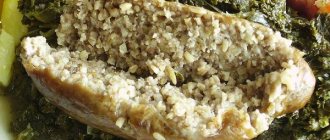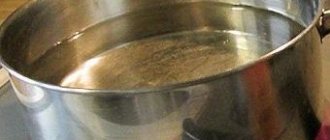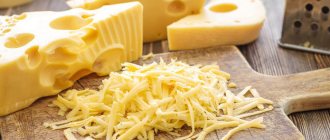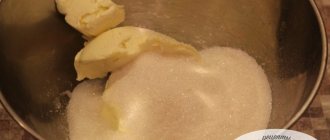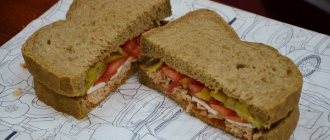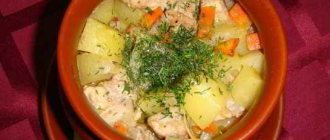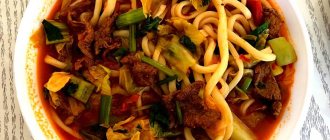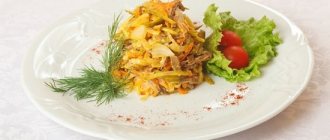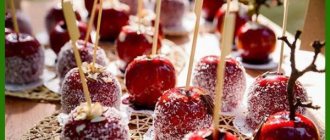Portuguese cuisine
mainly consists of simple dishes, the preparation of which uses fish and seafood, meat, cabbage and a huge selection of cheeses.
The Portuguese like to start lunch with hot dishes [ source not specified 623 days
].
Fish is used as the basis of dishes [ source not specified 623 days
].
The preferred meat is beef, although there are many different recipes for poultry [ source not specified 623 days
]. Vegetables are served whole (raw or boiled). The most popular include carrots, cauliflower and beans. Desserts and pastries are also worth mentioning in Portuguese cuisine. There is a large selection of desserts with almonds and cinnamon.
Most residents of Portugal have lunch at approximately the same time - from 12:30 to 13:30 [ source not specified 623 days
].
Fish
On the coast of Portugal they fish for sardines, tuna, crabs, shellfish and octopus. Residents often grill sardines on the grill. Also popular in Portugal is salted dried cod bacalhau, the special taste of which is given by spices. Each resident of Portugal eats on average about 16 kg of cod per year [ source not specified 623 days
]. In Lisbon they like to eat it with boiled potatoes and bread. The Portuguese also love crab croquettes.
Dried cod bacalhau
Recipe for success
The recipe for the original pastel de nata from the monastery in Lisbon is owned by only one confectionery factory, which bought it from the monastic order back in the 19th century. They are distinguished by their delicate puff pastry and dark spots on the caramel surface of the cream.
Andrew was familiar with the Hyatt pastry chef's version of pate de nata, but he didn't like the jelly-like texture the cornmeal added to the cream. He preferred the cream in pale yellow English tarts with a shortbread base - common in Hong Kong and Canton, they have long taken a place on the menu of traditional dim sum.
These are not pale British tarts, but 葡式蛋挞 in the making. Photo: Alina Kochetova
How long Andrew Stowe experimented with the recipe is unknown, but when he offered the first batch of future “Portuguese” tarts to his Portuguese friends, they were disappointed. This was definitely not the pastel de nata they had known since childhood. The local Chinese didn't like the tarts either: they didn't like the creme brulee spots.
At Lord Stow's Bakery, the tarts are not dusted with powdered sugar before baking, as many imitators do. Photo: Alina Kochetova
But despite the first negative reviews, soon buyers flocked to Coloane Island, where Andrew opened his bakery - not only locals, but also Hong Kong tourists, who dubbed the tarts “Portuguese.”
Meat
Francesinha
Cattle in Portugal are used for draft purposes and are rarely used for slaughter. Boneless pieces of meat are kept in wine for a long time and olive oil is rubbed into it, thanks to which it acquires a special taste. Deficiencies are corrected with the help of herbs, garlic and onions. However, they prefer boiled or stewed meat, which is cooked in the same bowl with vegetables, primarily beans [ source not specified 623 days
]. Spinach, Swiss chard (chard) and chickpeas (snap peas) are also often used. Portuguese steak is cooked in port wine sauce, and local kebab is marinated in port wine with garlic.
What is rich in Portuguese cuisine?
When you first go to Portugal, you go into a restaurant with apprehension, what if they only eat exotic things here?! In our opinion, Portuguese cuisine is traditionally European, with a small touch of the exoticism of the former colonies. The Mediterranean diet is present, but not dominant. Even though Portugal has 900 km of coastline, the Portuguese are meat eaters. What can I say, they have lard and in the beer hotel they sell cracklings in bags, along with salted peanuts or chips!
So, CNN has compiled a selection of factors that make Portugal one of the pearls of European cuisine. We are reading and planning to try it all!
1. Fresh ocean fish and seafood . The photo shows the famous PersEbash clam, which is boiled in salt water and its delicate pink muscle leg, with which it is attached to the stones, is eaten. Restaurants specializing in shellfish and fresh ocean fish are called marisqueira.
2. Liquid gold - olive oil . Olives grow not only in Italy, Spain and Greece!
3. Dish “cozido à portuguesa ”. In different regions of the country they prepare it differently, but it always turns out satisfying and with a variety of meat products and boiled vegetables.
4. Chefs . For example, José Avillez, Henrique Sá Pessoa, João Rodrigues, Pedro Lemos, Rui Paula, Vítor Matos.
5. Dishes from fish with a difficult fate - dried, dried and soaked cod, bakalYau . For example, pastéis de bacalhau, bacalhau à Brás, bacalhau à lagareiro, bacalhau com broa, bacalhau à Zé-do-Pipo, bacalhau com natas. Anticipating your amazement, I will say that this fish has already become a tradition and a “true friend” of the Portuguese. Like our herring or sprat. When they see herring, the Portuguese turn green and ask why we don’t eat it fresh! Haha, here is the answer to “why dried salted cod?”!
6. Cheeses. Cow's milk cheese is considered waste here, except for hard cheeses from the Azores. Goat and sheep cheeses are highly respected, namely semi-soft or soft ones that can be spread on bread.
7. Tripas à moda do Porto - a dish of beef tripe with beans, native to Porto. CNN also mentioned another dish from Porto, the hot French sandwich .
8. Dishes with rice. For example, arroz de marisco, arroz de pato, arroz de cabidela, arroz doce.
9. Cured pork ham presunto / prezunta, a relative of jamon and prosciutto.
10. Regional cuisine, formed due to the climate and terrain. Yes, yes, if you liked the dish in the Alentejo, most likely you will not find it in the north in the Minho region!
11. Wine. Vinho verde and port, dry aged wines from the regions of Douro, Alentejo and Dau, sparkling from Bairrada.
12 . The influence of the cuisine of the former colonies on Portuguese cuisine.
13. Suckling pig baked in an oven - leitau. The homeland of the dish is the Bairrada region, the cities of Anadia, Águeda, Mealhada.
14 . Fruits. Bananas from Madeira, pineapples from the Azores, cherries from the Serra da Gardunha mountains, oranges and figs from the Algarve, melons from the Alentejo region, plums from Elvas, Bravo Esmolfe apples.
15. Sardines . Grilled, fried in oil or canned.
16. Strange dishes , for example, lamprey with rice and its own blood, cod tongues and cheeks, pudding with added lard.
17. Fresh food markets
18. Portuguese sweets: pastries, puddings and mousses.
19. Portuguese chops, prego or bifana . In fact, it is simply a thin piece of pork or veal fried with sauce, without the “beating” process.
20. Kid and lamb, goat and lamb in red wine, rabbit, Barrosã and Mirandela veal, wild boar and venison.
We will introduce you to all these factors, to the best of your needs and capabilities, during our excursions and tours in Portugal!
Beverages
All wines are certified and produced only in areas specified by law [ source not specified 623 days
]. The most famous drink is port wine. It makes up about a third of the country's wine production. The rest comes from red and white table wines. The most famous white wine is Vin Verde (“green wine”), which is produced for export. The province of Alentejo produces aromatic and tart red wine. In Lisbon and some regions, ginjinha, a liqueur infused with cherries, is popular.
Pastel de Nata
The greatest fame in Portugal is gained by small golden baskets made of crispy puff pastry - pasteia (or pastel - in the singular). They are filled with a sweet custard made from sugar syrup, cream (or milk) and egg yolks. Confectioners add cinnamon and lemon zest to the dough, but all the main baking secrets are kept secret.
>>> Car rental in Portugal. Secrets of profitable rentals, features and Lifehacks <<
The cakes are served warm, just out of the oven. The top of the baskets is sprinkled with cinnamon and powdered sugar, and they especially like to order coffee as a drink. There is even a custom of serving pasta to guests while they are waiting for a takeout order or a table in a restaurant.
They say that monks in one of the Lisbon monasteries were the first to start preparing pasteis at the beginning of the 19th century. Subsequently, they sold their recipe to a Portuguese family, who started producing sweets.
The most famous pastry shop, where the famous Portuguese dessert is made, has been operating since 1837 and is called Fabrica de Pasteis de Belem. According to legend, it was its founders who became the owners of the secret recipe of the monks. Today, this bakery has practically become a tourist Mecca for all those with a sweet tooth who come to Portugal. One small basket costs €1.15 here.
National dishes
- Asorda - soup.
- Piri-piri chicken - with very hot red pepper.
- Bacalhau - salted cod. There are 365 ways to prepare it, one for each day of the year [ source not specified 623 days
]. - Caldo verde - thick cabbage and potato soup with chorizo
- Feijoada - baked black beans with dried meat, sausages, beef offal, garlic, etc.
- “Cousido portuguese” is a mixture of beef, pork, smoked meats and chicken.
How to make Portuguese cakes
- We take the yeast-free puff pastry out of the freezer in advance so that the dough is slightly defrosted and becomes elastic. This will take approximately 1 hour, follow the instructions on the product packaging for accuracy. Let's prepare the custard for the cakes. To do this, pour 100 ml of pasteurized milk at room temperature into a bowl with sifted wheat flour. Mix the ingredients thoroughly until a homogeneous thick mass is obtained.
- Pour the rest of the milk into a ladle. Add a cinnamon stick and lemon zest for flavor. Bring the milk to a boil, then remove the cinnamon stick and lemon zest from it.
- Constantly stirring the hot milk with a whisk, pour the flour mixture into it and remove from the heat. The result will be a thick white mass.
- Pour granulated sugar into a separate bowl and add water.
- Place a saucepan over medium heat to bring the mixture to a boil. Then boil the syrup for exactly 3 minutes after boiling. Pour it into the milk cream in a thin stream, constantly stirring the ingredients with a whisk.
- Let the cream cool a little. Add the yolks one at a time, thoroughly mixing the mixture with a whisk.
- The finished cream should be homogeneous and quite liquid, light yellow in color.
- Grease a special mold for baking cupcakes/muffins with butter so that the Portuguese cakes do not burn. Roll out the dough into a rectangle. Roll the 3 mm thick layer into a roll and cut it into 12 pieces.
- Place each piece cut side down on a cutting board and flatten it into a thin circle with the palm of your hand. Place each circle in a mold and form sides from the dough.
- Fill each piece with cream.
- Place the baking sheet in a hot oven. We will bake the cakes at high temperature (220 degrees) for 15-20 minutes (depending on the oven) until golden brown. Then carefully remove the cakes from the mold and serve with green tea or coffee. If desired, the baked goods can be sprinkled with aromatic ground cinnamon or sweet powder.
Drinks - for everyday life and holidays
Coffee
- served with sweets or just like that. The Portuguese have loved it since they began importing it from Brazil. During the day they drink tiny Espressos. They call it "caffeine", which can be translated into Russian as "coffee". In the morning, they prefer cappuccino with a head of strong milk foam.
Wine
- produced in all regions, plump catalogs and scientific tomes are dedicated to it. Young Vinho Verde is good for everyday life.
Port wine
- the real thing is produced only in the Douro River valley near Porto. Great for holidays and special days.
Ginja
- an exquisite liqueur infused with the fruits of a special variety of cherries. They pour it into small chocolate glasses, which they then snack on. You can taste different types in the ancient town of Obidos.
Agardente and medroña
- two varieties of legal moonshine. Firmly. For important days.
Come to Portugal and taste authentic Cusida, Portuguesa, Francesinho, Bacalhau, grilled sardines and delicious Pastel de Nata cakes. Don't miss out on the healthy green wine, true port and strong medroña. Tour operator "Lusitana Sol" hopes that you will go home well-fed, satisfied and dreaming of repeating the voyage.
Оvos moles
One of the national dishes of Portugal, which received geographically protected status from the European Commission, was a dessert from Aveiro with the unusual name “soft eggs”. These sweets in the shape of shells and fish are a thin shell of phyllo dough, under which lies a sticky sugar-yolk mass.
In Portugal they say that the dessert recipe appeared in a nunnery many centuries ago and, as it happens, by accident. The nuns did not know what to do with excess sugar and yolks (whites were used for ironing and starching clothes), and in the end they came up with an unusual and tasty delicacy, “ovush moles”.
Be that as it may, the original figured cookies today have acquired extraordinary fame far beyond the borders of Aveiro. For example, in Lisbon you can try it at Casa dos Ovos Moles em Lisboa.
Don't miss the opportunity to take this signature gastronomic souvenir home. In pastelarias, “soft eggs” are most often sold by weight at a price of 22-24 € per 1 kg and are packaged in simple white boxes. The dessert can be stored for up to three weeks; the main thing is to ensure careful transportation.
What other desserts to try in Portugal
In general, it is incredibly difficult to list all the desserts in Portugal, because the inhabitants of the country have an incredible sweet tooth. There are so many goodies in local confectionery shops that it seems that such an abundance cannot be found in any corner of the world! So, you will probably have the opportunity to try:
- Cavacas - small light cakes similar to profiteroles, covered with icing;
- Caramel flan - a delicious caramel dessert with a velvety and delicate texture;
- Malassada - hot round donuts, deep fried and sprinkled with sugar;
- Baba de camelo is an interesting dessert made from eggs and condensed milk, served cold;
- Salame de chocolate - a delicacy made from cocoa, crushed biscuits, butter, eggs and rum/port wine, somewhat reminiscent of sausage in shape;
- Pão de deus – sweet “bread of God”, topped with coconut glaze and sprinkled with powdered sugar;
- Arroz Doce – melt-in-your-mouth rice pudding with cinnamon and lemon flavors;
- Natas do céu - a delicate treat made from layers of crushed biscuits and a creamy egg mousse with custard on top;
- Pastel de Tentúgal - an envelope made of puff pastry without yeast filled with yolk-sugar mass;
- Sericaia – a fluffy sponge cake, traditionally served with plums boiled in syrup;
- Semifrio – semi-chilled cake with fruit filling, covered with light jelly;
- Serradura is another cold dessert made from crushed biscuits that are mixed with whipped cream and condensed milk;
- Peras bêbedas – “drunk pears”, or pears in a sweet syrup made from port and wine.
Tell your friends: Facebook
VK
Do not miss:
10 best restaurants in Lisbon
Port: an aristocrat among Portuguese wines
What to try in Portugal
Wines of Portugal
THE WHOLE TRUTH ABOUT ONLINE TOURS!!!
>>> Car rental in Portugal. All SECRETS, features and Lifehacks <<
14.04.2019
Tell your friends: Facebook
VK

